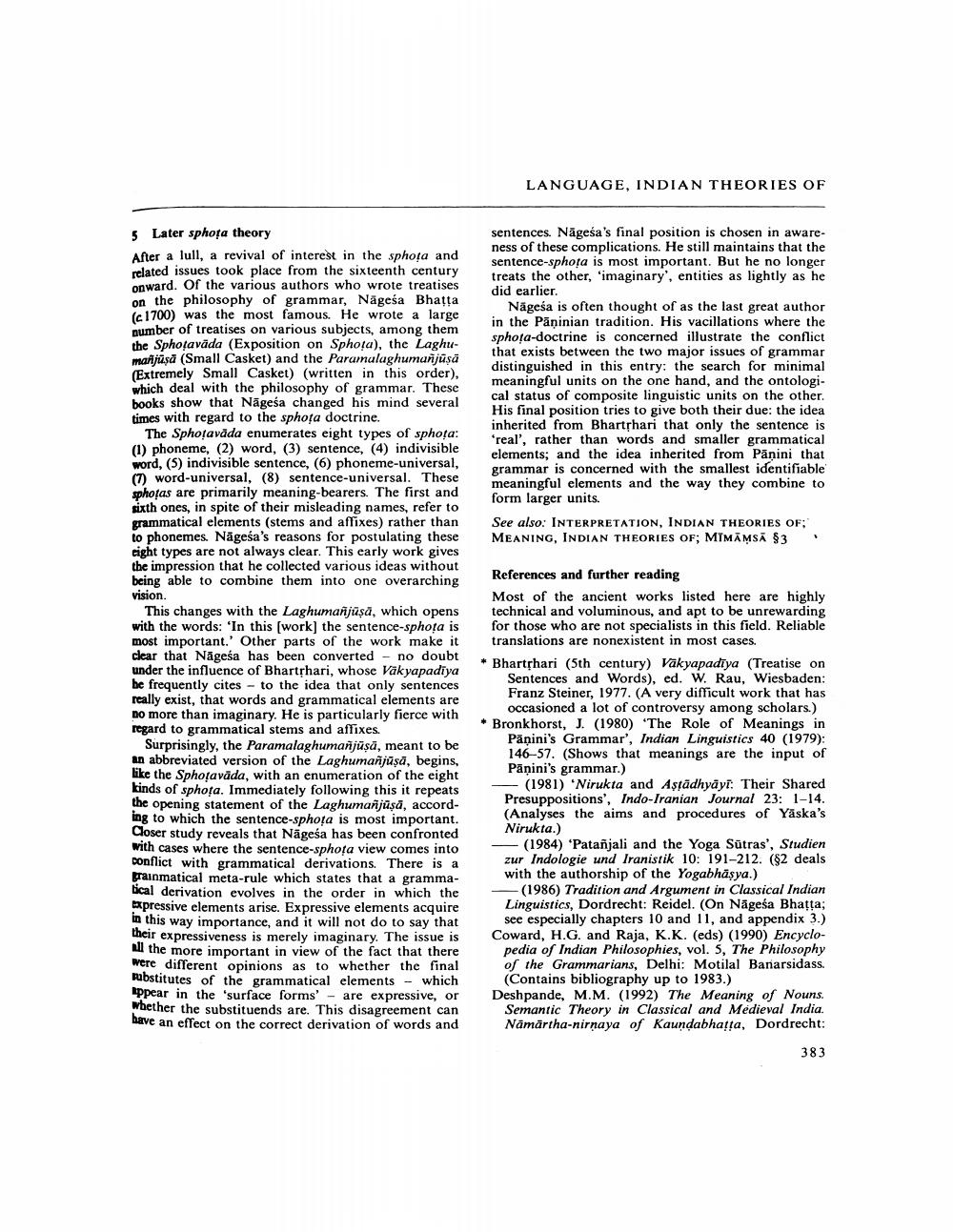Book Title: Language Indian Theories Of Author(s): Johannes Bronkhorst Publisher: Johannes Bronkhorst View full book textPage 5
________________ LANGUAGE, INDIAN THEORIES OF sentences. Nāgesa's final position is chosen in awareness of these complications. He still maintains that the sentence-sphota is most important. But he no longer treats the other, 'imaginary', entities as lightly as he did earlier. Nägeśa is often thought of as the last great author in the Pāninian tradition. His vacillations where the sphoța-doctrine is concerned illustrate the conflict that exists between the two major issues of grammar distinguished in this entry: the search for minimal meaningful units on the one hand, and the ontological status of composite linguistic units on the other. His final position tries to give both their due: the idea inherited from Bharthari that only the sentence is 'real', rather than words and smaller grammatical elements; and the idea inherited from Pāņini that grammar is concerned with the smallest identifiable meaningful elements and the way they combine to form larger units. See also: INTERPRETATION, INDIAN THEORIES OF: MEANING, INDIAN THEORIES OF; MTMĀMSĀ $3 5 Later sphota theory After a lull, a revival of interest in the sphoța and related issues took place from the sixteenth century onward. Of the various authors who wrote treatises on the philosophy of grammar, Nägesa Bhatta (c 1700) was the most famous. He wrote a large number of treatises on various subjects, among them the Sphotavāda (Exposition on Sphota), the Laghumanjūsă (Small Casket) and the Paramalaghumunjūsä (Extremely Small Casket) (written in this order), which deal with the philosophy of grammar. These books show that Nāgeśa changed his mind several times with regard to the sphoța doctrine. The Sphosavāda enumerates eight types of sphoța: (1) phoneme, (2) word, (3) sentence, (4) indivisible word, (5) indivisible sentence, (6) phoneme-universal, (7) word-universal, (8) sentence-universal. These sphofas are primarily meaning-bearers. The first and sixth ones, in spite of their misleading names, refer to grammatical elements (stems and aflixes) rather than to phonemes. Nāgesa's reasons for postulating these cight types are not always clear. This early work gives the impression that he collected various ideas without being able to combine them into one overarching vision. This changes with the Laghumañjūşa, which opens with the words: 'In this work] the sentence-sphoța is most important.' Other parts of the work make it clear that Nägeśa has been converted - no doubt under the influence of Bhartshari, whose Vak yapadiya be frequently cites - to the idea that only sentences really exist, that words and grammatical elements are no more than imaginary. He is particularly fierce with regard to grammatical stems and affixes. Surprisingly, the Paramalaghumanjuşā, meant to be an abbreviated version of the Laghumañjūşā, begins, like the Sphoțavāda, with an enumeration of the eight kinds of sphota. Immediately following this it repeats the opening statement of the Laghumanjuşā, according to which the sentence-sphoța is most important. Closer study reveals that Nägeśa has been confronted with cases where the sentence-sphora view comes into conflict with grammatical derivations. There is a grainmatical meta-rule which states that a grammatical derivation evolves in the order in which the bxpressive elements arise. Expressive elements acquire In this way importance, and it will not do to say that their expressiveness is merely imaginary. The issue is All the more important in view of the fact that there were different opinions as to whether the final Rubstitutes of the grammatical elements - which Eppear in the 'surface forms' - are expressive, or Whether the substituends are. This disagreement can have an effect on the correct derivation of words and References and further reading Most of the ancient works listed here are highly technical and voluminous, and apt to be unrewarding for those who are not specialists in this field. Reliable translations are nonexistent in most cases. * Bharthari (5th century) Vākyapadiya (Treatise on Sentences and Words), ed. W. Rau, Wiesbaden: Franz Steiner, 1977. (A very difficult work that has occasioned a lot of controversy among scholars.) * Bronkhorst, J. (1980) 'The Role of Meanings in Pānini's Grammar', Indian Linguistics 40 (1979): 146-57. (Shows that meanings are the input of Pāņini's grammar.) - (1981) Nirukta and Astādhyayi: Their Shared Presuppositions', Indo-Iranian Journal 23: 1-14. (Analyses the aims and procedures of Yaska's Nirukta.) — (1984) *Patanjali and the Yoga Sūtras', Studien zur Indologie und Iranistik 10: 191-212. (82 deals with the authorship of the Yogabhāşya.) - (1986) Tradition and Argument in Classical Indian Linguistics, Dordrecht: Reidel. (On Nāgeśa Bhatta; see especially chapters 10 and 11, and appendix 3.) Coward, H.G. and Raja, K.K. (eds) (1990) Encyclo pedia of Indian Philosophies, vol. 5, The Philosophy of the Grammarians, Delhi: Motilal Banarsidass. (Contains bibliography up to 1983.) Deshpande, M.M. (1992) The Meaning of Nouns. Semantic Theory in Classical and Medieval India. Nämärtha-nirnaya of Kaundabhatta, Dordrecht: 383Page Navigation
1 ... 3 4 5 6
